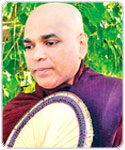|
Lesson for mindfulness - part 14:
Anger and
ill-will
 Battaramulla Battaramulla
Siri Sudassanarama
sadaham senasuna
Ven. Dr. Mirisse Dhammika thero
In the beginning of this Chapter we discussed anger and how to use mindfulness
to cope with angry feelings. Anger is often the result of having one’s strong
desires thwarted. As a result of these angry feelings, the student may start to
blame others, such as parents, teachers, friends, or even society in general,
for his/her unhappiness. “This is compared to having an illness which makes
everything taste bitter: to an irritated mind, the world is an irritating
place”. Therefore, in meditation, they should reflect on their anger and try to
be intimately acquainted with anger and is characteristics. What is anger? How
does it feel in the body, and in the mind? With is anger? How does it feel in
the body, and in the mind? With awareness and wisdom, they should perceive anger
as the root of an unpleasant state of mind. When the student focuses his
awareness fully and honestly inward towards his mind, he may see that the most
direct and immediate cause of his anger is in his mind. The external environment
is merely the trigger that activates the seed of anger in the mind. After some
period of mediation practice, they may learn to gently let go of their
hostility. As Weissman and Weissman state, “Forgiving ourselves, letting go of
the wise to manipulate others, is being they strong energy of aversion and
transforming it into the energy of compassionate understanding.”
Here I should point out that the meditator should build awareness gradually and
maintain it at every moment. Impatience for a better result is
counterproductive. What is important to making progress is growth in
understanding. Through understanding the unsatisfactory and painful nature of
anger, hatred and aversion, people can cultivate the ability to see into
themselves more clearly. They can make their minds healthier by channeling their
mental energy into feelings of compassion and forgiveness towards themselves. By
practicing meditation in this way, anger and its related feelings such as hatred
will lose power over the meditator. I will discuss compassion towards self and
others in more detail in Chapter 4 when I describe the Metta Sutta, or
Loving-Kindness meditation.
Dullness and Drowsiness
The third hindrance, dullness and drowsiness, or lack of attention or the
inability to concentrate properly, indicates that our mind is not alert and
focused enough. Of course, dullness and drowsiness can be a result of physical
fatigue, but here we are concerned with drowsiness and low energy in the absence
of physical fatigue. It is in a sense a ‘lazy” mind. When we see drowsiness
appear, we should appreciate that this is a natural function of the mind,
especially in the untrained or undisciplined mind. The untrained mind is
unstable and shaky in that it cannot maintain concentration on a single object
of subject for even a short period of time. For the undisciplined mind, one
thought comes and is quickly overpowered by the next thought. A perfect analogy
would be like bubbles in a stream: one bubble appearing and being quickly
replaced by another, as they all flow along. The untrained mind lacks energy and
determination, and this results from the “unstableness” of the mind. Some
students are drowsy most of the time, and it may lead to inertia, especially
when doing their schoolwork. “This is compared to being in jail: one is
incarcerated in one’s passive state: not engaging with any worthwhile activity,
one gets nothing out of life”. Whenever they feel drowsiness, they should try to
become more awake by becoming more aware: they should practice mindfulness on
their drowsiness. |
